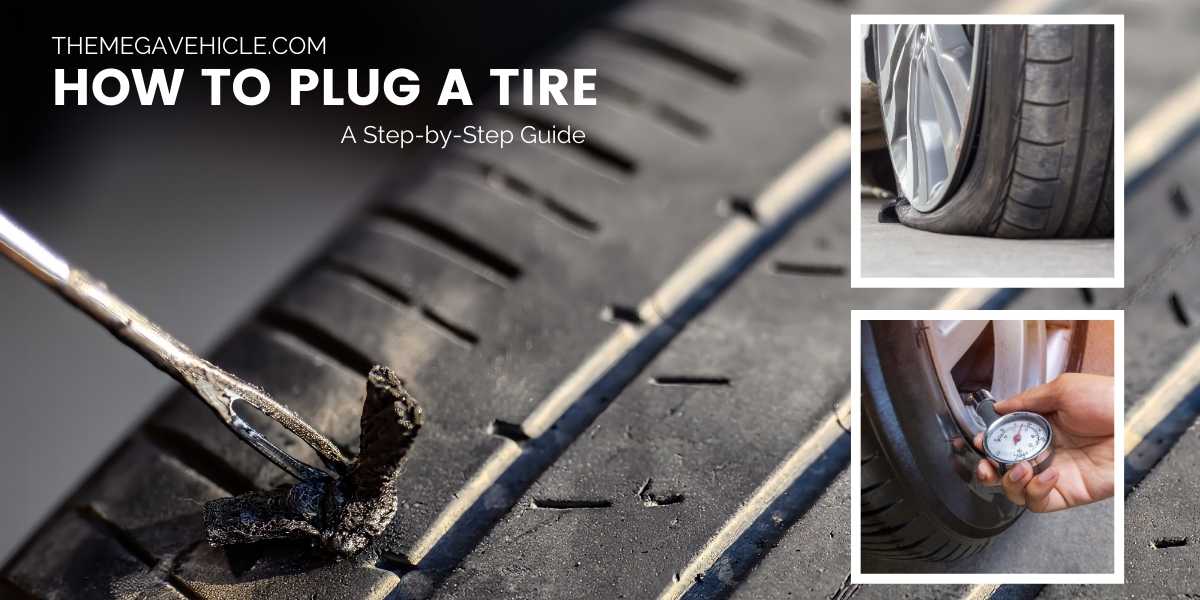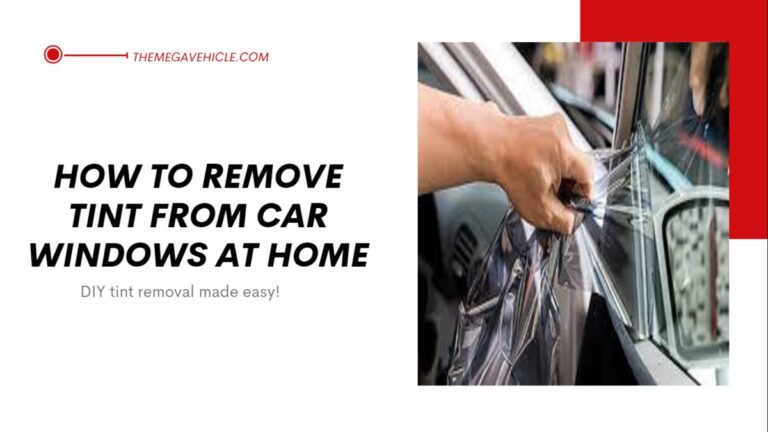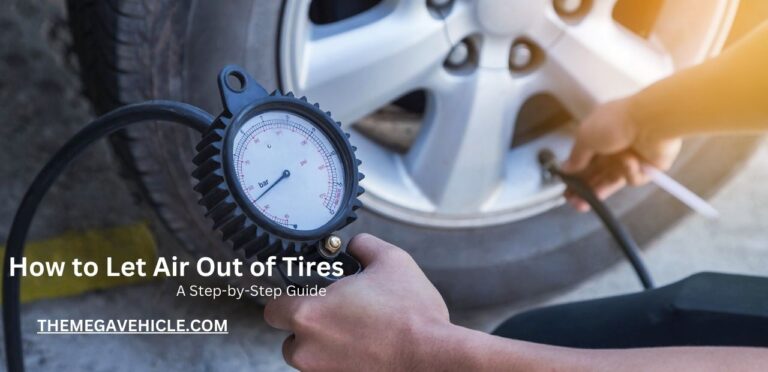How to Plug a Tire: A Step-by-Step Guide

Knowing how to plug a tire is an important skill for every driver to have. A flat tire can happen at any time, and if you’re not prepared, you can be stranded on the side of the road for hours. Knowing how to plug a tire can help you get back on the road quickly and safely.
Here are some of the benefits of knowing how to plug a tire:
- Save time and money: Plugging a tire is a much cheaper and faster option than having to replace the tire.
- Avoid being stranded: If you get a flat tire in a remote area or at night, knowing how to plug a tire can be a lifesaver.
- Peace of mind: Knowing that you can fix a flat tire on your own can give you peace of mind when you’re on the road.
What a tire plug is?
A tire plug is a temporary repair solution for a punctured tire. It is made of a rubber or synthetic material that is inserted into the hole in the tire and sealed with glue. Tire plugs can be installed by a tire shop or by yourself using a tire plug kit.
Tire plugs are not a permanent solution, but they can last for several thousand miles if properly installed. It is important to have the tire inspected by a tire professional regularly to make sure that the plug is still holding and that the tire is safe to drive on.
Tools and materials needed to plug a tire
- Tire plug kit: This kit contains all the essential tools and materials to plug a tire, including tire plugs, glue, and insertion tools.
- Utility knife: This is used to clean the area around the puncture and to trim the excess tire plug flush with the surface of the tire.
- Pliers: These are used to grip the end of the tire plug and insert it into the puncture.
- Air compressor: This is used to inflate the tire to its recommended pressure after the plug has been inserted.
- Jack: This is used to lift the vehicle so that you can remove the tire.
- Lug wrench: This is used to remove the lug nuts that hold the tire in place.
Safety equipment:
- Safety glasses: These protect your eyes from flying debris when you are using the utility knife.
- Gloves: These protect your hands from sharp edges and hot surfaces.
How to Plug a Tire: A Step-by-Step Guide
1. Preparation
- Remove the tire from the vehicle: Park the vehicle on a level surface and engage the parking brake. Use a jack to lift the vehicle and a lug wrench to remove the lug nuts, then slide the tire off the wheel. Removing the tire is necessary because it is difficult to locate the puncture and remove the object causing the puncture while the tire is still on the vehicle.
- Locate the puncture: Use a flashlight to inspect the tire tread for the puncture. It may be a small hole or a nail or screw sticking out of the tire.
- Remove the object causing the puncture: If the puncture is caused by a nail or screw, use pliers to remove it. If the puncture is too large to be plugged, you will need to replace the tire.
2. Inserting the plug
- Use the reamer to clean the puncture hole: The reamer is a tool included in the tire plug kit. It is used to clean and widen the puncture hole. Insert the reamer into the hole and twist it in a clockwise direction.
- Thread the plug through the insertion tool: The insertion tool is also included in the tire plug kit. It has a hole in the end that the tire plug is threaded through. Push the plug through the hole until the end of the plug is flush with the end of the insertion tool.
- Insert the plug into the puncture hole: Lubricate the plug with the rubber cement or sealant included in the tire plug kit. Then, insert the plug into the puncture hole with the insertion tool. Make sure that the plug is inserted all the way into the hole.
3. Sealing the plug
- Trim the excess plug material: Use a utility knife to trim the excess plug material flush with the surface of the tire.
- Apply rubber cement or sealant to the plug: Apply a generous amount of rubber cement or sealant to the plug and the surrounding area of the tire.
- Allow the sealant to dry: Allow the sealant to dry completely before inflating the tire.
4. Checking for leaks
- Inflate the tire to the recommended pressure: Use an air compressor to inflate the tire to the recommended pressure. The recommended pressure is usually listed on the sidewall of the tire.
- Apply soapy water to the plugged area: Use a spray bottle to apply soapy water to the plugged area.
- Look for bubbles indicating leaks: Look for bubbles forming around the plugged area. If you see any bubbles, the plug is not sealing properly and you will need to repeat the process.
Once you have confirmed that the plug is sealing properly, you can reinstall the tire on the vehicle and drive away.
Tips and precautions for plugging a tire
Plugging a tire is a temporary solution for a punctured tire. It is important to follow the manufacturer’s instructions carefully when plugging a tire to ensure that the repair is done correctly and that the tire is safe to drive on.
Here are some tips and precautions for plugging a tire:
Tips
- Use the correct tire plug kit for your tire. There are different types of tire plug kits available for different types of tires. Make sure to use the correct plug kit for your tire to ensure a proper repair.
- Wear safety glasses and gloves. Safety glasses protect your eyes from flying debris and sharp edges. Gloves protect your hands from cuts and abrasions.
- Park on a level surface and engage the parking brake. This will prevent the vehicle from rolling while you are working on the tire. If you are parking on a slope, you may also want to block the wheels with chocks.
- Avoid over-inflating the tire. Over-inflating a tire can cause it to burst, which can be dangerous for both you and other motorists. When plugging a tire, it is important to inflate it to the recommended pressure, which is usually listed on the sidewall of the tire. To inflate the tire, use an air compressor. Be careful not to overinflate the tire. If you are unsure about how much air to put in the tire, consult a tire professional.
Precautions
- Regularly inspect the plugged tire: After plugging a tire, it is important to inspect it regularly for any signs of damage or leakage. This will help to ensure that the repair is holding and that the tire is safe to drive on. Look for any signs of damage to the tire, such as cracks, bulges, or tears. Check the tire pressure regularly and make sure that it is at the recommended pressure. If you notice any signs of damage or leakage, take the tire to a tire professional to have it inspected.
- Have the plugged tire inspected by a tire professional: It is important to have the plugged tire inspected by a tire professional as soon as possible to ensure that the repair is holding and that the tire is safe to drive on.
Additional Tips
- Be aware of your surroundings. If you are plugging a tire on the side of the road, be careful of traffic and other hazards.
- Use a flashlight if you are working in low-light conditions.
- Be careful not to overtighten the lug nuts. Overtightening can damage the wheel and make it difficult to remove the tire in the future.
By following these tips and precautions, you can ensure plugging the tire in a safe and effective way to repair a puncture. It is important to note that tire plugs are not a permanent solution. If you notice any signs of wear and tear on the plug or the tire, it is time to replace the plug or the tire altogether.






